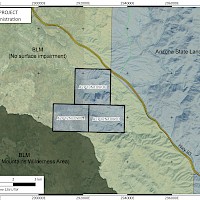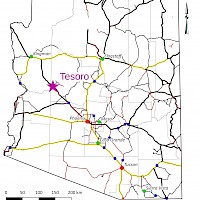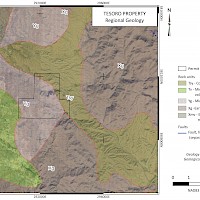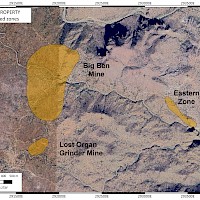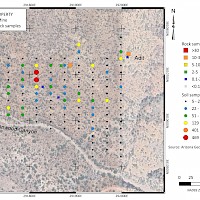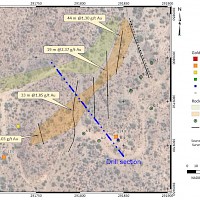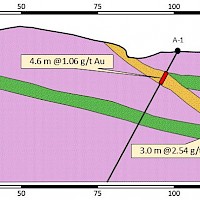The Tesoro Project is centred at 34° 25’ N 113° 15’ W in Yavapai County, Arizona and covers all of Section 36, Township 13 N, Range 10 W and Sections 1 and 2, Township 12N Range 10W. The Property is 70 km northwest of Wickenburg. The principal showings on the property can be reached by road with a four-wheel drive high-clearance vehicle with access off Highway 93.
History
Silver Range has not performed any exploration on the Tesoro Project lands and the data reported herein is drawn from public domain summaries and data in the Arizona Geological Survey mining records database.
The principal showings on the Tesoro Property are denoted the Big Ben Mine and Lost Organ Grinder Mine, asserted without attribution to be the source of visible gold reported in area during the 1860’s. While there are old shafts and adits in the area, there is no information conclusively linking the two known occurrences to the reported lost mines.
The Big Ben Mine is named after Ben McLendon one of the earliest American prospectors in Arizona. He arrived from Georgia after escaping captivity during 1861 and was one of the Weaver Party that discovered the eponymous district at Rich Hill in 1963. The following year he settled in Wickenburg to the south and shortly thereafter appeared with a burro-load of gold-bearing quartz. He repeatedly reappeared with shipments which he would grind and then use the proceeds for a celebration and supplies. He was eventually found about four miles from Wickenburg, murdered with his dead burro nearby. Ben McLendon never disclosed the location of his mine but most rumors placed it north of Wickenburg in the general area of the Tesoro Project.
There are several conflicting narrations of the Lost Organ Grinder Mine story. The consensus is that a trio of itinerant Italian musicians equipped with hand cranked organs and three monkeys left La Paz on the Colorado River bound for Granite Creek near Prescott in 1865. On their journey, they encountered an old man near death from starvation and thirst. After nursing him back to recovery, the Mohave Indian offered to express his gratitude to the party by showing them a gold mine with widespread gold. The party of four reached the Santa Maria River after two days travel across the desert and then on the third day reached “a deep canyon up in the hills north of Peeples Canyon”. The Italians found an outcrop several hundred metres west of their campsite with visible gold and collected several small bags of specimens. Running out of food, they covered up their find, drew a location map and headed out by night to avoid attack by the Hualpai Apache who lived in the area. Two days travel southeast took them to Tres Alamos Springs where they rested. Unfortunately, the party was ambushed there by the Haulpai and all but one of the Italians was killed, the survivor having escaped and hidden during the attack. He later returned, burned his dead companions, released the three monkeys and headed towards Wickenburg. Near dead from thirst, he was found collapsed in the desert by Francisco Gonzales, a teamster heading from Weaver Creek to Wickenburg. Gonzales put him in the wagon, fed him some water and was transporting him to Wickenburg when he died, after telling the Gonzales the story of his ordeal and mineral discovery. By one report, he had buried the map beneath a boulder at the site of the Apache attack and by another the map ended up in the possession of Abraham Peeples, the organizer of the original Weaver Party and Ben McLendon’s original employer. In any event, the mine was not conclusively relocated. An interesting video summary of the Lost Organ Grinder Mine story may be found here: https://www.youtube.com/watch?v=Db4cCdWHUSo
The Keystone Gold and Copper Company staked claims in the area is 1901 (Muller, 1973) but no record of their work is readily available. In 1982 and 1983, the ground covered by the Tesoro Property was optioned by New Tyee Resources Ltd. (Organ Grinder Mine) and HiMac Resources Ltd. (Big Ben Mine). New Tyee conducted sampling, mapping, cut 6 trenches and drilled 7 reverse circulation drill holes at the Organ Grinder Mine in 1984. HiMac conducted sampling and soil geochemical surveys at the Big Ben Mine. Both companies dropped their options in 1985. In 2006, Sage Gold Inc. took out permits on the Big Ben Mine showing and announced high grade gold sample results. No further work was reported. Silver Range applied for and received preliminary permits for the Tesoro Project in May 2025.
Geology & Mineralization
The Tesoro Project area is mostly underlain by Mid-Proterozoic granite. This unit hosts gold occurrences throughout northwestern Arizona, primarily in steeply-dipping northwest trending structuers. Historic reports describe two styles of gold mineralization on the property. The first consists of narrow, northwest-striking, steeply dipping quartz veins carrying high grade gold values, a style of occurrence common in these rocks. The second, noted at the Organ Grinder Mine, consists of wider, gently dipping altered granite carrying gold in the 1-5 g/t Au range. The latter was of particular interest to recent exploration groups who saw the potential for the property to host low grade, bulk tonnage gold amenable to heap leaching. At the Big Ben Mine, surface rock samples collected by Sage Gold returned up to 52 g/t Au while soil samples returned up to 9.2 g/t Au. A soil grid installed at this showing by HiMac Resources Ltd. detected a strong gold-in-soil anomaly, open on strike, with sample responses up to 1,500 ppb Au.
Future work
Silver Range is applying for permits and intends to conduct geologic mapping, soil geochemical & rock sampling followed by ground geophysics to define drill targets at the Tesoro Project.

